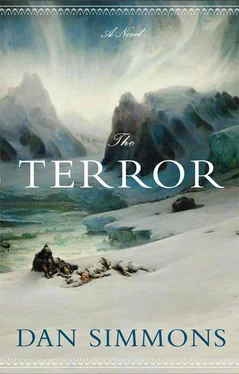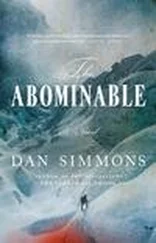Tom Blanky realized that he had become just so much more dead weight for the exhausted and ill survivors – ninety-five of them now, not including Blanky – to haul south with them.
What kept Blanky going even when his third leg began to splinter – there were no more extra spars from which to whittle a fourth – was his rising hope that his skills as an ice master would be needed when they took to the boats.
But while the scrim of ice on the rocks and barren coastline melted during the day – sometimes the temperature rose as high as 40 degrees according to Lieutenant Little – the pack ice beyond the coastal bergs showed no sign of breaking up. Blanky tried to be patient. He knew better than any other man on the expedition that sea ice at these latitudes might not show open leads – even on a “more normal” summer such as this one – until mid-July or later.
Still, it was not only his usefulness that was being decided by the ice, but his survival. If they took to the boats soon, he might live. He did not need his leg to travel by boat. Crozier had long since designated Thomas Blanky as skipper of his own pinnace – commanding eight men – and once the ice master was at sea again, he would survive. With any luck at all, they could sail their fleet of ten little splintered and gouged boats right to the mouth of Back’s Great Fish River, pause at the mouth to rerig for river running, and – with only the slightest help from northwest winds and men at the oars – head briskly upstream. The portages, Blanky knew, would be hard, especially hard for him since he could carry so little weight on his flimsy third peg, but a piece of cake after the man-hauling nightmare of the last eight weeks.
If he could last until they took to the boats, Thomas Blanky would live.
But Blanky knew a secret that made even his sanguine personality wane: the Thing on the Ice, the Terror itself, was after him.
It had been sighted every day or two as the straining procession of men had rounded the large cape and turned back east again along the shoreline, every day in the early afternoon when they turned back to haul the five boats they’d left behind, every twilight at around 11:00 p.m. as they collapsed into their wet Holland tents for a few hours’ sleep.
The thing was still stalking them. Sometimes the officers saw it through their telescopes as they looked out to sea. Neither Crozier nor Little nor Hodgson nor any of the other few officers remaining ever told the man-hauling men that they’d seen the beast, but Blanky – who had more time than most to watch and think – saw them conferring and knew.
At other times, those hauling the last boats could see the beast clearly with their own unaided eyes. Sometimes it was behind them, trailing by a mile or less, a black speck against white ice or a white speck against black rock.
It’s just one of them polar white bears , had said James Reid, the red-bearded ice master from Erebus and one of Blanky’s closest friends now. They’ll eat you if they can, but mostly they’re harmless enough. Bullets kill them. Let’s hope it comes closer. We need some fresh meat .
But Blanky knew at the time that it wasn’t one of the white bears they shot for food from time to time. This was it , and while all men on the Long March feared it – especially at night or, rather, during the two hours of dimness that now passed for night – only Thomas Blanky knew that it was coming for him first.
The march had taken a toll on everyone, but Blanky was in constant agony: not from scurvy, which seemed to be affecting him less than most, but from the pain in the stump of the leg that the thing had taken. Walking on the ice and rock of the shore was so difficult for him that by midmorning of each day’s sixteen- or eighteen-hour march, his stump would be streaming blood down over the wooden cup and leather harness that held it in place. The blood soaked through his thick canvas trousers and ran down his wooden peg, leaving a trail of blood behind. It soaked upward through his long underwear, trousers, and shirt.
During the first weeks of the march, while it was still cold, it was a blessing that the blood had frozen. But now, with the tropical warmth of days above zero, some above freezing, Blanky was bleeding like a stuck pig.
The long slops and greatcoats also had been a blessing – they hid the worst evidence of Blanky’s bleeding from the captain and others – but by mid-June, it was too warm to wear the greatcoats while hauling, so tons of sweat-soaked slops and wool layers were piled in the boats they were hauling. The men often hauled in shirtsleeves through the warmest parts of the day, pulling on more layers as the afternoons cooled toward zero degrees. Blanky had joked with them when they asked him why he continued to wear his long coats. I’m cold-blooded, boys , he’d said with a laugh. My wooden leg brings the chill of the ground up into me. I don’t want you to see me shiver .
But eventually he had to take off the greatcoat. Because Blanky was working so hard hobbling just to keep up, and because the pain of his tortured stump caused him to sweat even when he was standing still, he could no longer stand the freeze-and-thaw, freeze-and-thaw of all his layers of clothes.
When the men saw the blood pouring, they said nothing. They had their own problems. Most of them were bleeding from scurvy.
Crozier and Little often would pull Blanky and James Reid aside, asking the two ice masters their professional opinion about the ice just beyond the berg barrier of the shoreline. Once they’d come around to the east again, along the southern coast of this cape that had bulged out miles to the west and south of Comfort Cove – probably adding twenty miles to their haul south – Reid was of the opinion that the ice between this part of King William Land and the mainland, whether King William Land was connected to the mainland or not, would be slower breaking up than the pack ice to the northwest, where conditions were more dynamic come the summer thaw.
Blanky was more optimistic. He pointed out that the bergs piled here along this southern coast were becoming smaller and smaller. Once a serious barrier separating the shore from the sea ice, this wall of bergs was no more a hindrance now than a cluster of low seracs. The reason, Blanky told Crozier, and Reid had agreed, was that this cape of King William Land was sheltering this stretch of sea and coast, or perhaps of gulf and coast, from the glacierlike river of ice that had poured down so relentlessly from the northwest onto Erebus and Terror and even upon the coast near Terror Camp. That endless press of ice, Blanky pointed out, had been flowing down from the North Pole itself. Things were more sheltered here south of the King William Land southwestern cape. Perhaps the ice would break up sooner here.
Reid had looked at him strangely when Blanky delivered that opinion. Blanky knew what the other ice master was thinking. Whether this is a gulf or a strait leading to Chantrey Inlet and the mouth of Back’s River, ice usually breaks up last in a confined space .
Reid would have been correct if he’d stated that opinion aloud to Captain Crozier – he hadn’t, obviously not wanting to contradict his friend and fellow ice master – but Blanky was still optimistic. In truth, Thomas Blanky had been optimistic in his heart and soul every day since that dark night of 5 December of the previous winter when he’d considered himself a dead man as the Thing on the Ice chased him from Terror and into the forest of seracs.
Twice the creature had tried to kill him. And twice all that Thomas Blanky had lost had been parts of one leg.
He hobbled on, bringing cheer and jokes and the occasional shred of extra tobacco or sliver of frozen beef to exhausted, drained men. His tent mates, he knew, valued his presence. He took his turn at watch in the ever-shorter nights and carried a shotgun while painfully stumping alongside the morning boat procession as a guard, although Thomas Blanky knew better than any living man that no mere shotgun would stop the Terror Beast when it finally came in close to claim its next victims.
Читать дальше












